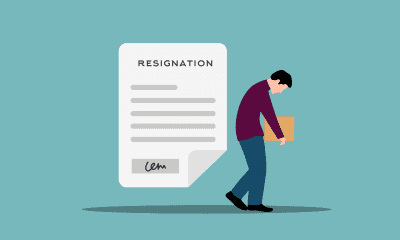Business
Benefits Of Having Dogs At The Office
Published
6 years agoon

Taking along your furry friend to your workplace is not a distant dream anymore. Many offices are becoming pet-friendly. This is not an amusing fact, but a well-researched one. A dog can give you a bit of relief when you are completely tied-up with your work. If the pet is well-trained and perfectly healthy, you can take your dog in your office. If your co-workers are open to the idea of keeping a pet in the office, and the building authorities permit pets, then no one can hold you back. Here are the benefits of having dogs in your workplace:
Relieves stress
An active dog is an instant mood-booster. You feel relieved when you see the lively eyes of your pet. If you play with your dog for a few minutes, you get back the strength to work with high-efficiency. Anyone can have a rough day at the office. If a cute-looking Labrador or St. Bernard is there, you can overcome negativity almost instantly.
Helps in team-rapport
Dogs can act as a bonding factor for the team in the workplace. In some offices, people do not get along very easily. A dog can immediately change the environment. It melts the ice and everyone starts sharing their thoughts about keeping a pet. A friendly dog can bring everyone together. A pet can be a great topic as a conversation-starter. Even a new employee can settle down quickly in the new environment when a gentle-looking dog is there.
Reduce absentees
If pet-owners can come to work along with their pets, it becomes a huge relief for them. They can concentrate better on their work and perform well. Pets can feel lonely and bored and often fall sick when they are left alone at home. Workers may find different excuses to skip work to be with their pets. If they can bring their pets, they work peacefully and do not take frequent leaves.
Encourages healthy living
In most offices, employees are stuck for hours on their laptops. Sitting constantly for hours and looking at the screen can have adverse effects on the health of the workforce. If there is an office dog, the employees can take the dog for a walk. They can also share the responsibility of taking care of the dog. It will encourage them to stay active and happy in the workplace.
Dogs make the place more human
A dog or cat can completely change the plastic environment of the workplaces. People become so engrossed in their work, that they slowly ignore their human feelings for each other. Frequent dog petting or cuddling can help people come out of their robot-like situations in the office.
Pets stimulate creativity
Pets can provide natural pauses in workflow. The small breaks allow the human brain to relax and think outside-the-box. Pets allow you to relieve stress and think creatively. The more time you spend with your canine friend, the more relaxed you feel. A calm and fresh mind always bring the best idea in the workplace.
To increase the productivity and happiness of your employees, dogs can play an important role. You can arrange some training for the office people if they want a furry friend in the office premises.
You may like
‘Or Die Trying’ Webseries Empowering Millennials
BumpOut: The Expandable Portable Speaker
Design Hack Your Office For Maximum Productivity
Kemetria Lilly Founder of Lilly’s Kloset: 5 Tips for Aspiring Entrepreneurs
Safety Hacks For Traveling To Your Next Business Meeting
Retain Your Employees Through Company Culture
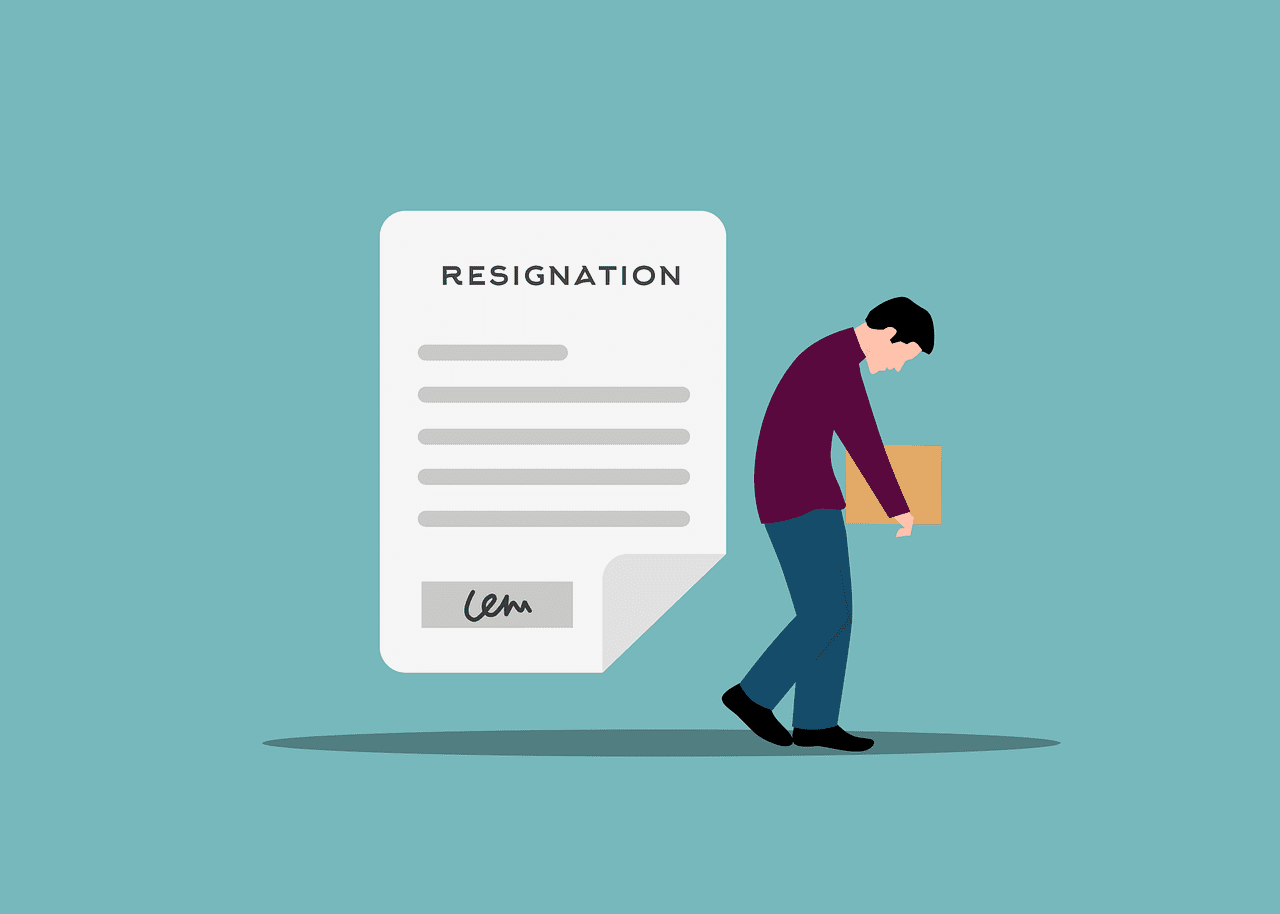
Introduction
Did you know that 84% of businesses reduce staff as their first response to financial trouble? It’s often the easiest decision on paper, but it’s also one of the most damaging in the long run.
Now imagine you’re a CEO in this position. Sales are down, profits are shrinking, and every advisor around you is saying, “Start letting people go.” What would you do?
This is exactly where Sarah Jennings, CEO of a mid-sized digital agency, found herself. But instead of cutting jobs, she took a different path. She refused to lay off a single employee and still managed to cut costs by 70%. How? By rethinking expenses, using innovative tools like Penji, Adaptify, and Flowpages, and focusing on what truly mattered.
This is her story and what you can learn from it.
Cut Costs by 70%: Refusing Layoffs and Finding a Better Way
When Sarah first looked at the numbers, the situation seemed bleak. Revenue had dropped by nearly 50% in six months. The company was losing money every quarter. Most CEOs in her position would’ve reduced payroll immediately.
But Sarah had a different philosophy. “People are the heart of this company,” she told her leadership team. “If we lose them, we lose everything that makes us valuable.”
That mindset shaped every decision she made moving forward.
Step 1: Look Closely at Every Dollar
The first thing Sarah did was review every single expense. This might sound obvious, but many companies skip this step because it’s tedious. Not Sarah.
She pulled up the company’s financial statements and went line by line. She asked simple but powerful questions:
- Do we still need this?
- Is there a cheaper way to do it?
- Does this help us deliver value to clients?
Within weeks, she found thousands of dollars being spent on tools nobody used, office perks that no one noticed, and overlapping software subscriptions. By cutting these, the company saved a significant amount—without affecting employees or customers.
You can do this, too. It’s not glamorous, but when you track every expense, you’ll often uncover waste you didn’t know existed. If you’re curious about more ways business owners adapt to challenges like this, check out OwnersMag for real-world stories and strategies.
Step 2: Change How Work Gets Done
After tackling unnecessary spending, Sarah turned to how the team worked. She realized inefficiency was eating up time and money.
Instead of hiring expensive in-house designers, the company switched to Penji, a flat-rate graphic design service. This allowed the team to get unlimited design work for a predictable monthly cost—no more overpaying for one-off projects.
For marketing campaigns, Sarah’s team used Adaptify, an AI-driven platform that automated ad optimization. It reduced the need for manual testing and improved ROI.
Finally, they adopted Flowpages, a digital tool for creating shareable, mobile-friendly landing pages in minutes. This replaced expensive custom landing page builds.
By embracing these solutions, Sarah freed her team from repetitive tasks and reduced operational costs dramatically.
Step 3: Focus on What Matters Most
With spending streamlined and processes improved, Sarah turned her attention to priorities. The company had been chasing too many small projects, trying to please everyone. This spread resources thin.
She gathered her team and asked a simple question: “Which clients and projects bring us the most value?”
The answer was clear. A small group of loyal, high-value clients drove most of the company’s revenue. Sarah decided to focus on them. This meant saying “no” to low-profit work, even if it felt risky.
The result? The company’s profits stabilized, and employees had more time to deliver exceptional results to their best clients.
The Outcome: Cut Costs by 70% Without a Single Layoff
Six months later, Sarah’s company was thriving again. By cutting waste, improving processes, and focusing on value, they managed to cut costs by 70%, while keeping every employee on the payroll.
The best part? Morale was higher than ever. Employees felt valued and motivated because they knew the company had their backs. Clients noticed, too. The business started winning new contracts thanks to its reputation for stability and quality.
What You Can Learn from Sarah’s Approach
If you’re facing financial pressure, you might feel like layoffs are the only answer. But Sarah’s story proves otherwise. You can:
- Audit your spending carefully. Look for waste you can remove without hurting core operations.
- Leverage smart tools. Services like Penji, Adaptify, and Flowpages can save you money while maintaining quality.
- Prioritize what matters most. Focus resources where they have the biggest impact.
It’s not easy, but it’s possible and the payoff can be huge.
Conclusion
Sarah’s journey shows that cutting costs doesn’t have to mean cutting people. By taking a thoughtful, strategic approach, she saved her company, protected her employees, and built a stronger business for the future.
You can apply the same principles in your own work. Start small. Review your expenses. Use the right tools. And always remember that your people are your most valuable asset.
FAQs
1. Can you really avoid layoffs during a financial crisis?
Yes, with strategic cost-cutting and efficient tools, layoffs aren’t always necessary.
2. What’s the easiest way to start cutting costs?
Begin with a detailed expense audit to identify waste.
3. Are services like Penji, Adaptify, and Flowpages affordable?
They’re typically cheaper than hiring full-time staff or outsourcing ad hoc work.
4. How long does it take to see results from these changes?
Most companies see savings within the first few months.
5. Does focusing on fewer clients really help profits?
Yes, concentrating on high-value clients often increases efficiency and revenue.
Business
7 Effective Ways to Improve at Networking and Grow Your Brand
Published
5 days agoon
August 19, 2025
Believe it or not, networking works. If you want to grow your business, you need to connect with people and apply networking tips – whether in face-to-face meetings, hybrid events, or online meetings. And when you want networking to work for you, you must be pushy and assertive but polite.
Read here to know the ways to improve at networking:
1. Identify Your Goals

The first thing you need to do is to determine what you want to get out of the task. Ask yourself, what am I looking for? Once you understand your goals and objectives, it’s easier to identify which events to go to. This way, you can find which ones are better aligned with your business to get more productive results. This will also assure you that your efforts won’t go to waste.
2. Research the Events
Once you determine your goals and line up a few events to go to, do a bit of research. Try to get as much data about them as possible. It is also highly recommended that you get to know the people attending these events. If you see a company you’re interested in, you should find out more about it before going.
In 2025, research isn’t limited to physical events. Many networking opportunities now happen online or in hybrid formats. Before joining, check if the event has a digital platform or app where you can view the agenda, profiles of attendees, and discussion threads. Preparing your LinkedIn profile or digital business card in advance will make it easier to connect with others, even virtually. Taking the time to engage in pre-event online conversations or forums can also help you stand out and build rapport before you meet people in person.
3. Wear the Appropriate Clothing

They say, “dress to impress,” and this rings true when attending networking events. Choose clothes that will make you feel comfortable while suitably dressed for the occasion. You can wear bright-colored clothes for a casual event and be the ice-breaker. Or add an accessory that can be a conversation starter. This way, socializing becomes more effortless and you will get more people to network with.
One of the ways to improve at networking in terms of fashion is to focus not just on formality, but on authenticity and sustainability. Many professionals now prefer smart-casual looks that reflect their personal brand while also considering eco-friendly or minimalist fashion choices.
For hybrid or online events, remember that your on-screen presence matters too: choose solid colors that look good on camera, avoid overly busy patterns, and ensure good lighting. Dressing in a way that aligns with your values and professional identity will make you more memorable in both physical and virtual spaces.
4. Practice Makes Perfect
It pays to rehearse what you’ll say to people about your company. You can stand in front of a mirror and practice your pitch so you won’t have to forget an important detail. Remember to include your achievements to make them see how your business will help them improve theirs. A little bit of humble brag will go a long way.
5. Create a Killer Business Card

There will be exchanges of business cards at these events, so make sure that yours will stand out. There are many websites you can go to where you can design your own. Ensure that all pertinent data is on it, so people aren’t left hanging. In addition, make sure that your design will grab attention and won’t have the card end up in the trash bin.
These days, business cards aren’t just physical, but digital too. Many professionals now use QR codes, NFC-enabled cards, or LinkedIn QR sharing to exchange details instantly. Having a sleek digital business card or profile ready ensures you’re remembered even after the event ends. For in-person events, a thoughtfully designed physical card still makes an impression, but pairing it with a scannable digital version gives your contacts more ways to connect. This hybrid approach prevents your information from being lost and makes follow-ups easier.
6. Be Prepared
Also included in the best ways to improve at networking is to set yourself at ease and relax, especially if it’s going to be a long event. Get your socializing skills warmed up by getting a drink, if applicable. This can also set the mood for the event to help you start talking to people. Once you get the conversation going, you should engage in active listening.
As much as you want people to absorb what you’re saying, you should do the same. Allot a time for each person you talk to and stick to that time. Then, excuse yourself politely to start conversing with other people. Hand over your business card and move on to the next prospect.
Don’t worry about offending people; many networking event attendees understand the transactional nature of them. Give them a promise to follow up and end the conversation.
7. Follow the Best Practices
After you go to one event, analyze your moves and try to make a pattern of what worked. This can help you avoid mistakes such as wasting your time with one company and other similar situations. Also, think of the best lines that will quickly convey your message. Think of networking as speed dating, so arm yourself with the best pickup lines.
In 2025, best practices go beyond clever one-liners. Many networking platforms now use AI-powered apps that track who you’ve met, remind you to follow up, and even suggest conversation starters. After events—whether in-person or virtual—take time to review not just who you spoke with but also how you engaged online, such as LinkedIn comments, virtual chatrooms, or community follow-ups.
One of the most important ways to improve at networking is to focus on building authentic, long-term connections rather than just rapid-fire introductions. Documenting key insights digitally will help you refine your approach for the next event and create a more intentional networking strategy.
Business
Fiverr vs Penji vs Canva: Who Comes Out on Top for Creatives?
Published
1 week agoon
August 15, 2025By
Skylar Lee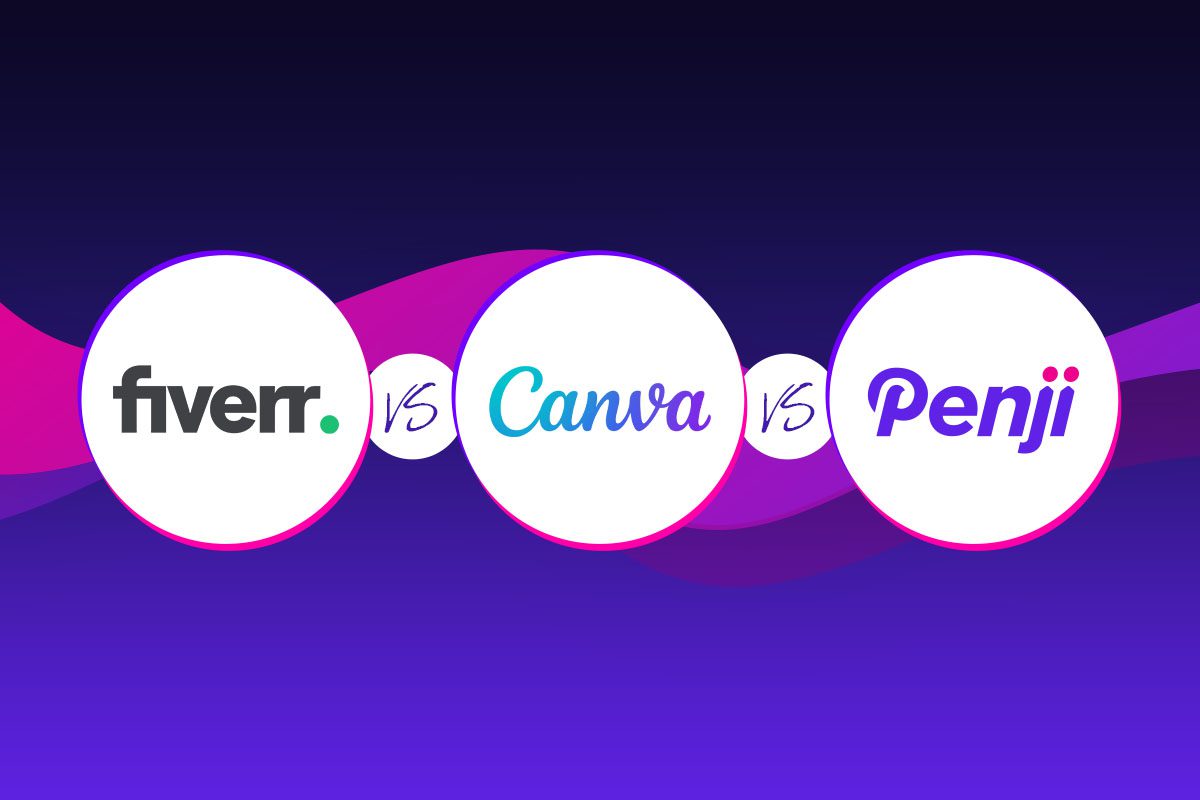
Fiverr vs Canva vs Penji – which one should you choose?
Strong graphic design is no longer optional—it’s essential for standing out in today’s competitive market. Skimping on design could mean losing ground to competitors who are investing in high-quality visuals.
The good news? Accessing professional design has never been easier. From hiring skilled freelancers to creating your own designs or using subscription-based services, the options are vast. In this post, we’ll compare Fiverr vs Penji vs Canva, highlighting the leading choice in each category so you can find the best fit for your brand’s needs.
Companies Overview
Let’s start our Fiverr vs Canva vs Penji review with a brief introduction to each company.
Fiverr
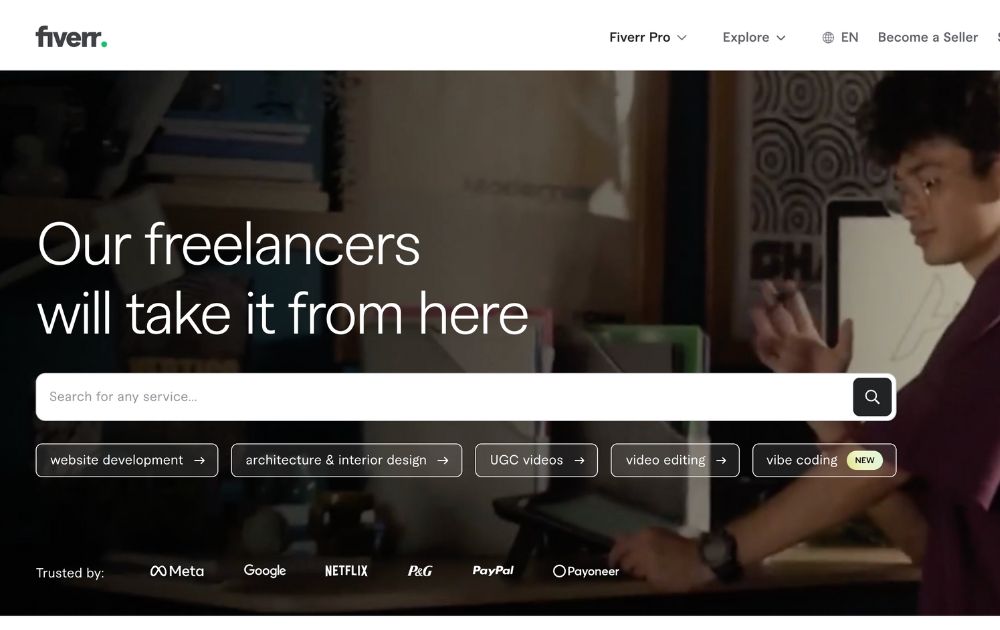
Fiverr is a freelance gig platform for hiring remote workers, like web developers, podcast editors, video editors, and many more. Graphic designers are also available to hire on Fiverr with a wide scope of services. On Fiverr, you can browse various design styles to find the right designer for your project.
Penji
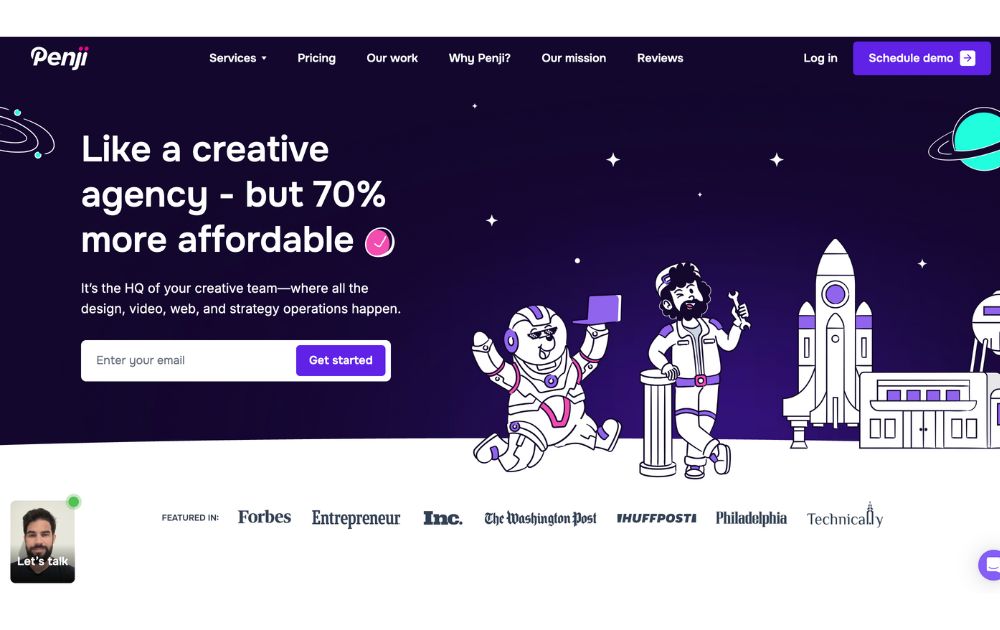
One of the highest-rated design services, Penji is a subscription-based graphic design service. You can subscribe and request as many designs projects as you want on a rolling basis. With Penji, you get access to 120+ design types, including web and app designs, presentation designs, motion designs, and illustrations. Plus access to art directors or project managers depending on what tier you choose.
Canva
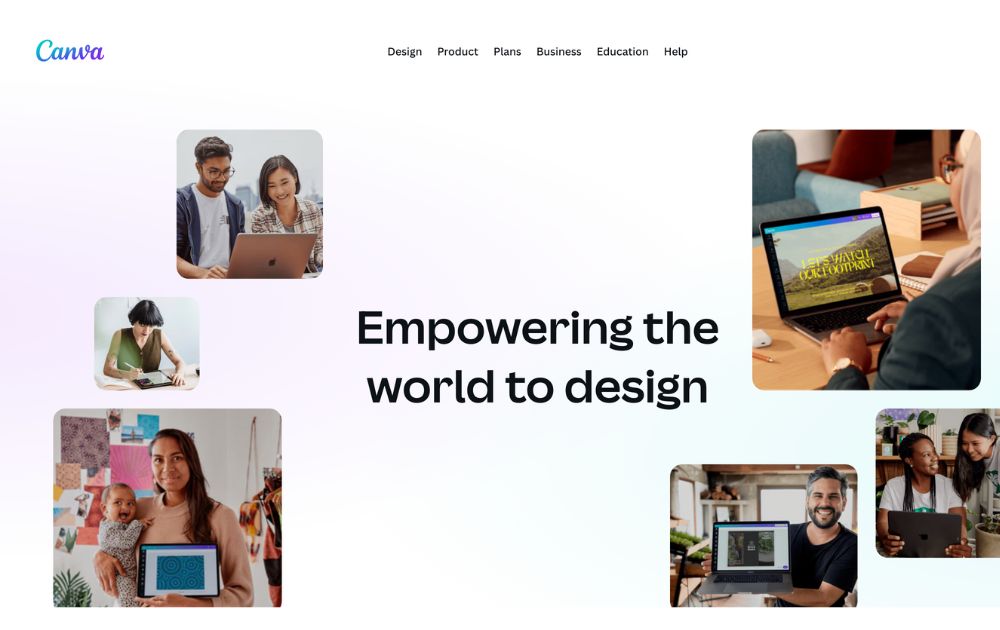
Canva is a do-it-yourself graphic design application that will help you design anything related to your business. You don’t need graphic design experience to use Canva. They offer templates to help you get started with designs like YouTube thumbnails or ads. Plus, you can edit those templates based on your unique branding.
Fiverr vs Canva vs Penji Features
Next in our Fiverr vs Canva vs Penji showdown, let’s check out the features of each to see which one reigns supreme.
Fiverr
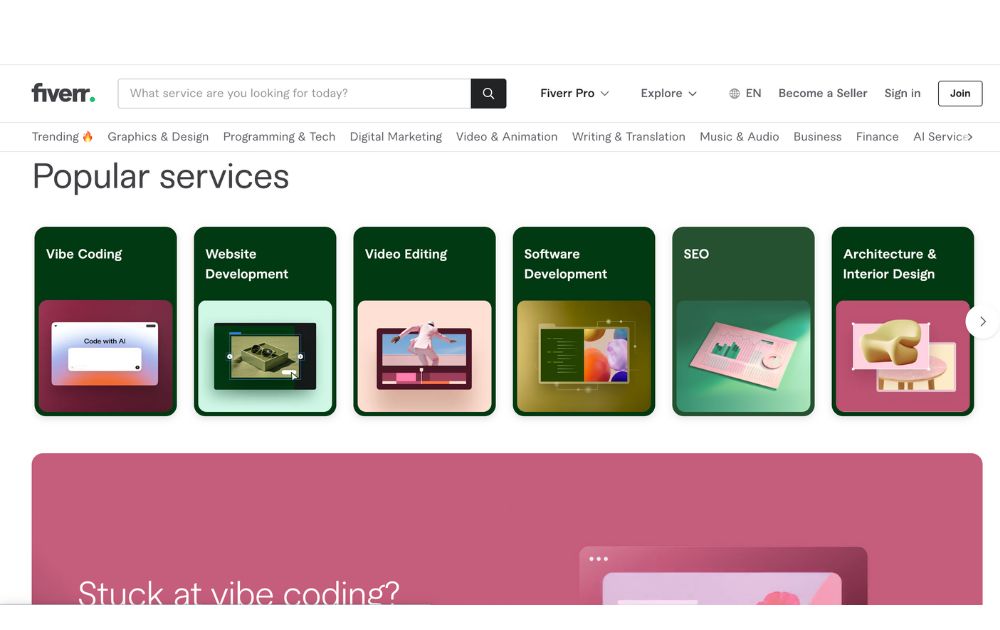
Fiverr provides businesses with two ways to find freelancers. First, you can find them using the search bar. Type “graphic designer” and find available designers to collaborate with. You can narrow your search by finding designers based on your design needs. For instance, you can browse “logo designers” instead of graphic designers.
As you select graphic designers, you can see that designers offer various plans depending on your design project. Plus, they indicate the following:
- Number of designs they can create
- Number of revisions
- Turnaround time
Plus, you can also find reviews from previous clients to know their working experience with one of your top choices.
The other way to find freelancers is the Fiverr Enterprise platform. Fiverr specialists will help you find the best graphic designers, creatives, and other employees for your team. Plus, the platform includes onboarding, management, payment, and compliance.
Penji
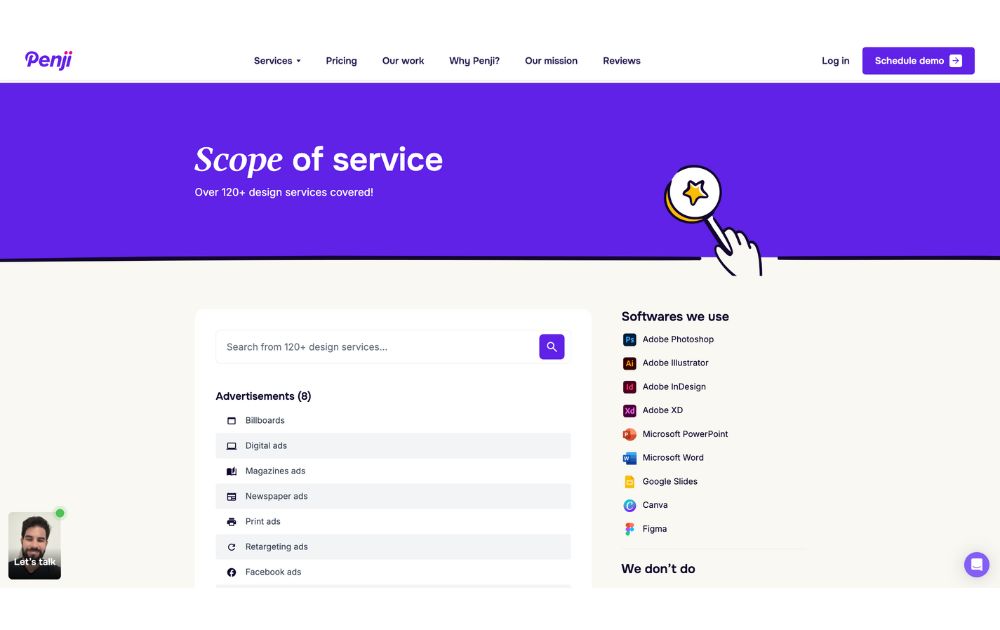
Penji has many features to get you started, from submitting your first request to chatting directly with your designers. You simply click “Create” in the top right corner of the dashboard, submit your design brief, and get matched with the appropriate designer right away.
Here’s what to expect when subscribed to Penji:
- Request 120+ designs
- Get matched with the best designer for your project
- Swap designers if needed
- Manage multiple brands
- Point and click revisions
- Team collaboration
- Designer chat window
- Real-time updates
Canva
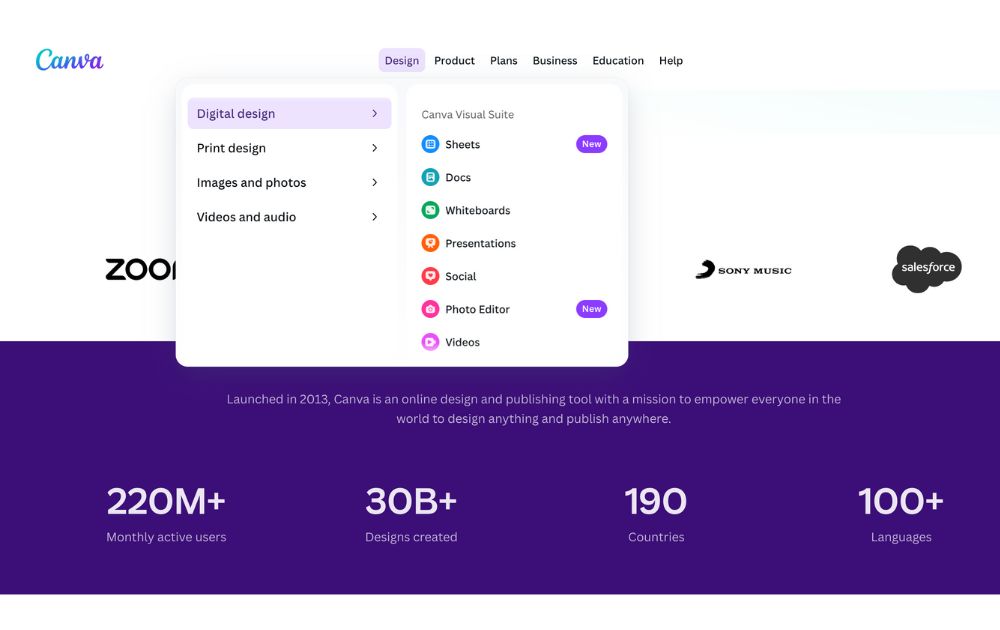
Meanwhile, Canva is a software loaded with many intuitive features to help you design your own projects. Features depend on the plan you choose. However, here are the basics:
- Drag-and-drop editor
- Access to 1 million templates, 3 million photos and videos, and thousands of design types
- AI-generated designs
- Printing and delivery
However, if you need more than that, you can access the following on the paid plans:
- Resize and translate designs
- Brand kits
- Remove backgrounds
- 1TB of cloud storage
- 24/7 customer support
Turnaround Time
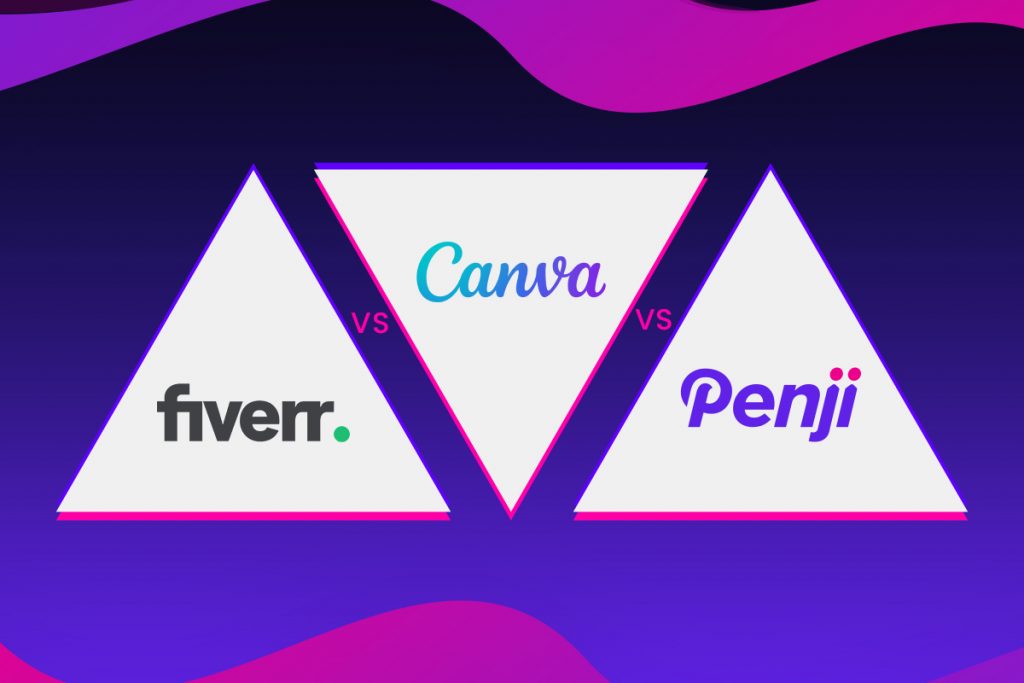
Turnaround time for Fiverr freelancers depends heavily on the graphic designer. They will indicate how long the delivery date would be. Some designers are quick (1-2 days), while others will take weeks for more involved projects.
Penji guarantees a 1 to 2-day turnaround time on most designs. If you’re subscribed to the Agency plan, they can even ensure same-day turnaround. However, complex projects like web or app designs will take longer.
Of course, if you’re using Canva, turnaround time is simply however long the project takes you! Again, this can vary depending on your design skills and whether or not you find the design elements you’re looking for.
Fiverr vs Canva vs Penji Pricing
Fiverr pricing depends on what designs you need. But as the name suggests, Fiverr refers to the $5 starting point that freelancers can charge clients with when working with them. However, there’s always the risk of poor quality. It’s best to vet each designer carefully and choose something reasonably priced.
Penji’s pricing is simple because you pay a flat monthly rate for all design work. Here are the pricing options depending on what tier of service you choose:
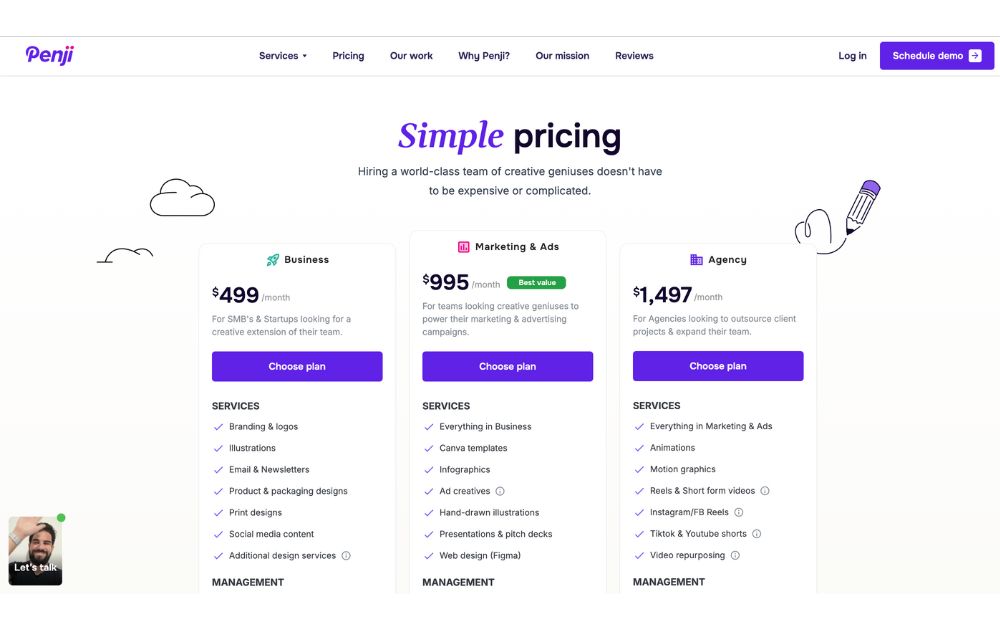
Lastly, Canva has three pricing tiers, depending on your needs and budget.
- Canva – Free
- Canva Pro – $15/mo
- Canva for Teams – $10/mo (minimum 3 users)
Design Work and Production
Next, let’s see Fiverr vs Canva vs Penji in terms of design work and production.
Design work by Fiverr freelancers varies from experience level to design specialties. Many Fiverr freelancers produce decent work for clients, considering the rates they charge. However, not all design work from Fiverr is 100% the best. Considering Fiverr is the best for short-term work, expect one or a few design variations for a project.
For Canva, we can use templates as the point of comparison for design work. Thousands of creators submit their templates to the graphic design software. Many templates look the same because it is the trend or looks modern. Regardless, Canva templates look decent to use as the base design for your brand. However, you need to modify it to your brand to avoid using similar templates from competitors or other brands.
Finally, Penji produces highly custom designs for clients. Because the price point is a bit higher, their design team can take the time to ensure you get the exact version of what you’re looking for. Penji isn’t a freelance platform, so you may get the chance to work with the same designers again and again (especially if you prefer their work).
Competitor Analysis
One fair comparison to make is between Fiverr and Penji since both deal with actual designers and their work. Here are a couple of comparison points for these two services to help you narrow your options further.
- Design variations – Fiverr freelancers can create a few variations. Meanwhile, Penji designers can produce multiple variations since you can switch between designers.
- Work volume – Fiverr designers can produce a limited number of designs, depending on plan inclusions. Ideally, they’re a good option for one-off projects. However, Penji can produce more than 10+ designs, especially if you have a monthly volume of designs.
- Comfort – Penji allows you to sit back and run your company since it’s an extension of your team. Meanwhile, you need to browse and interview freelancers on Fiverr. Plus, you have to worry about payment and management.
But if we were to put Canva back into the equation, Canva has the upper hand in pricing. Plus, if you’re creative enough, you can produce great brand designs without the help of designers.
Final Thoughts
Graphic design work can be done and delivered in three main ways: doing it yourself, hiring a freelancer, or subscribing to a graphic design service.
As we’ve seen in this three-way Fiverr vs Canva vs Penji showdown, each has its strengths and weaknesses. The three services have different models, which could benefit users or subscribers in getting their designs. It’s up to you which is the best design service for your situation. Good luck!

How a CEO Refused Layoffs and Still Cut Costs by 70%

7 Effective Ways to Improve at Networking and Grow Your Brand

Meta Sphere AI: New AI Knowledge Tool Based on Open Web Content

Prowly Review: Boost Your Media Relations with Ease

Fiverr vs Penji vs Canva: Who Comes Out on Top for Creatives?

5 Highest Rated Design Services Used by Big Brands & Agencies

Oppo Air Glass: A Ground-Breaking AR Technology Experiment?

Augmented Reality Contact Lenses: A Breakthrough in AR

Prowly Review: Boost Your Media Relations with Ease

5 Highest Rated Design Services Used by Big Brands & Agencies

Fiverr vs Penji vs Canva: Who Comes Out on Top for Creatives?

7 Effective Ways to Improve at Networking and Grow Your Brand

Oppo Air Glass: A Ground-Breaking AR Technology Experiment?














